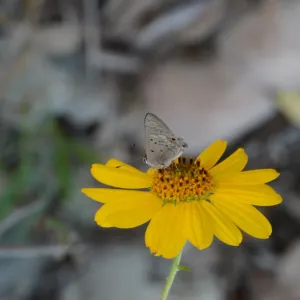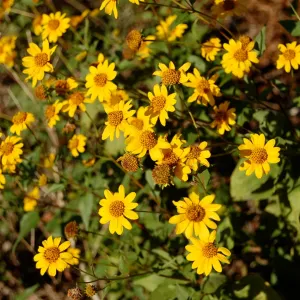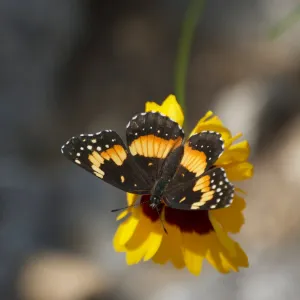By Delmar Cain
by Delmar Cain — Boerne Chapter, Native Plant Society of Texas
Published in the Boerne Star on October 11, 2013
When you hear “goldeneye” what comes to mind? Do you think of fiction, fowl or flora? If you are a movie buff, you probably, think of the seventeenth Bond movie starring Pierce Brosnan, which was based on some of the characters created by Ian Fleming but was not the work of Ian Fleming.
If you are a bird enthusiast, you might think of a duck, the common goldeneye, which winters along the Gulf Coast. You might even think of the Barrow’s goldeneye that is found in Alaska, Canada and Iceland and only makes it as far south as the northern parts of the United States.
But if you are a gardener or a native plant admirer, probably you will think of one of two species from the Sunflower tribe of the Acanthus Family, which are native in our area and inhabit many of our landscapes. One of those species, skeleton-leaf goldeneye, (Viguiera stenoloba) is the October Plant of the Month for the NICE Program (Natives Instead of Common Exotics) of the Boerne Chapter of the Native Plant Society of Texas (NPSOT).

Skeleton-leaf goldeneye or resinbush, as it is sometimes called, is a many-branched evergreen shrub that grows 2-4 feet tall and spreads an equivalent distance. It has bright green leaves that are narrow and thread-like. Its handsome yellow daisy-like flowers are 1-1/1/2 inches across and bloom during the summer and early fall. The result is a round-shaped attractive plant that is drought tolerant and versatile for many locations in garden and commercial settings.
Resinbush grows natively in South and west Texas, New Mexico and south into Mexico.
It is found on the dry, rocky limestone and caliche soils that are abundant in these areas. Growing in areas that do not receive abundant rain it is hardy in requiring little water and withstanding the cooler temperatures that can be found in the desert and sub-desert landscapes. It can grow in either full sun or part shade, but it does require good drainage.
When in bloom it is visited by nectar-loving insects including bees, moths and butterflies.
Birds eat its seeds and deer occasionally browse its new leaves, but tend to avoid it after it matures. Many commercial nurseries sell skeleton-leaf goldeneye. But it can also be found at those nurseries like Medina Garden Nursery in Medina that sell primarily native plants. For planting and care instructions, check the plant of the month at the Boerne NPSOT website: http://www.npsot.org/wp/boerne/

A second Hill Country species, known most widely as goldeneye (Viguiera dentate), has many other common names, including sunflower goldeneye, plateau goldeneye, toothleaf goldeneye and chimalacate. It is very common on the eastern edge of the Hill Country and is found more sparingly westerly to Arizona and south into Central America.
It is also a perennial, which grows in part shade in a variety of soils including the dry limestone-based sands and loams of our area. It is found at the edge of woodlands and in savannahs and meadows. It is a wonderful addition to a residential landscape.
This other goldeneye is also a much-branched open plant, 3-6 feet tall with many yellow flowers heads, appearing from September through November. The flowers are up to 1¼ inch wide. Its leaves are ovate (shaped like a spoon but with a point) and are 3-6 inches in length. If its stalks are left in the winter, the birds will appreciate the seeds and the missed seeds will form colonies.

Goldeneye also attracts nectar-imbibing insects and is a host plant for the cassius blue butterfly and for the bordered patch butterfly. If you choose to buy this plant at the Medina Garden Nursery in Medina, you stand a good chance of seeing these butterflies while you shop.
Finally, I would like to note the passing of one of the oldest and most faithful readers of this column. When Bill Ward started Native Grown in 2001, he often stated that the only person that he knew who read the column was his mother, Louise Ward. In the months after Bill died in 2010, Kathy Ward, Bill’s wife and Louise’s long-time caretaker, assured me that Louise steadfastly continued to read the column. Louise Ward died on October 3, 2013 at the age of 98. Those of us who write this column will miss her and we appreciate her years of loyalty.
